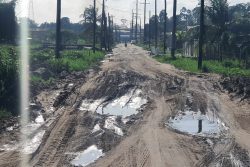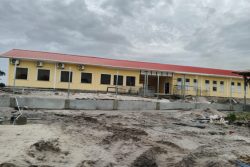Ulric Trotz is the Deputy Director & Science Adviser, Caribbean Community Climate
Change Centre, Belmopan, Belize
Two years ago in Paris, at the Conference Of Parties (COP) of the United Nations Framework Convention of Climate Change (UNFCCC), the global community concluded the historic Paris Agreement, which was hailed at the time as the platform for serious global action to address the existential risks engendered by climate change. The agreement called for countries to take action to significantly reduce their Green House Gas (GHG) emissions, so as to limit the increase in the global average temperature to well below 2 degrees centigrade, and to pursue efforts to limit the temperature increase to 1.5 degree centigrade above pre-industrial levels, recognizing that this would significantly reduce the risks and impacts of climate change.
The two degree target was agreed at the COP in Copenhagen in 2009 but at that time, the Caribbean and other Small Island Developing Countries (SIDS) espoused a 1.5 degree limit for global warning, as successive studies emphasized the dangers of a two degree warming world and the difficulty of avoiding “runaway” climate change were global warming to exceed the 1.5 threshold. The Caribbean SIDS developed the mantra “1.5 to stay alive” and campaigned vigorously at international fora and intervening COP meetings ,to ensure that the global community took their concern on board in negotiating any global agreement on global warming. The fact that the Paris Agreement reflects their concern can be considered a victory for SIDS and other vulnerable developing countries and a credit to the excellent advocacy for the 1.5 target by our negotiators.
The Paris Agreement called on all countries to define what actions they would take nationally to achieve the target of GHG reduction required to achieve the objective of limiting the extent of global warming. All countries have now done so through the submission of their Nationally Declared Contributions (NDCs) to the United Nations Convention of Climate Change (UNFCCC) secretariat, which are no more than statements of intent with no requirement for compliance and no penalty for non-compliance. A back of the envelope calculation also shows that the sum total of emissions reduction that can be achieved, were all the NDCs to be fully implemented, was inadequate for the realization of the Paris agreement objective and would put the world on a trajectory to experience warming of 3.0 degree Centi-grade by 2100 – that is 1.5 degree warmer that the 1.5 limit called for by SIDS!! Countries are expected to submit revised NDCs by 2020 and it is hoped that these would be much more “ambitious” than the present ones and would be adequate to achieve the 1.5 target in 2100.
The Paris Agreement also directed the Intergovernmental Panel on Climate Change (IPCC), the climate science arm of the UN, to provide a Special Report by 2018. The report would address the impacts of global warming of 1.5 degrees above pre-industrial levels and related global GHGs emissions pathways, in the context of strengthening the global response to the threat of climate change, sustainable development and efforts to eradicate poverty. Published last month, the IPCC report reflected the unanimous conclusions of world scientists on the consequences of a 1.5 warmer world, compared to one that is warmer, and the possibilities for achieving the goals of the Paris agreement, especially in the context of pledged national actions as reflected in existing NDCs and actions to limit global warming to the level articulated in the Paris agreement.
It is noteworthy that Caribbean scientists at the Climate Studies Group at Mona (CSGM) in Jamaica, the Institute of Meteorology (INSMET) in Cuba, The University of Suriname and the Climate Change Centre in Belize, carried out studies on the consequences of a 1.5 degree warmer world for the region and produced four peer reviewed papers that were quoted in the IPCC report. The study concluded that the Caribbean has already seen significant impacts under a 1.2 degree Centigrade global rise in mean temperatures and that a 1.5 global threshold will possibly occur by the mid 2030’s. The 1.5 threshold will see further significant changes in climate patterns for the region and there are statistically significant differences between the mean state and occurrence of extremes for 1.5 and 2.0 degree warming. This is in keeping with the IPCC report which for example points out that at 1.5 warming about 70% of the world’s coral reefs would be destroyed but at 2.0 degree warming 90% or more of global reefs would be destroyed. The study confirms that there is need for even greater global action to ensure that global temperature rise does not exceed the 1.5 threshold.
The IPCC report confirmed Caribbean concerns about the two degree target and concluded that there are robust differences in regional climate characteristics between present day and global warming of 1.5 degrees and between 1.5 and 2 degrees. These differences include increases in mean temperature in most land and ocean regions, heat extremes in most inhabited regions, high precipitation in several regions and the probability of drought and precipitation deficits in some regions.
Most alarmingly, the report concludes that at the present rate of global GHGs emissions, we are on track to attain the 1.5 degree warming by 2030!! Keep in mind that our aspiration under the Paris agreement is to reach this level of warming by 2100. To achieve the latter, the report states that for 1.5 warming, GHG emissions need to decline by about 45% from 2010 levels by 2030, reaching net zero by 2050 (net zero emissions are achieved when emissions are balanced globally by removals e.g. through forest sequestration). For the 2.0 degree, target emissions will need to decline by 20% by 2030 and made net zero around 2075.
The report also concluded that to achieve the required target set in the Paris agreement, globally, there must be rapid and far reaching transitions in energy, land use, urban infrastructure (including transport and buildings) and industrial systems. System transitions are unprecedented in terms of scale, but not necessarily in terms of speed (e.g. the transformation of the American manufacturing system to a war machine during World War 2). The report observes that this implies deep reductions in all sectors, a wide portfolio of mitigation options and a significant upscaling of investments in those options.
In view of the IPCC report, it is legitimate to ask questions about the status quo of global action to meet the thresholds defined in the Paris agreement. Some indication of this can be gleaned from the Climate Action Tracker (CAT). CAT is an independent scientific analysis produced by three research organisations tracking climate action since 2009. It tracks progress towards the globally agreed aim of holding warming well below 2°C, and pursuing efforts to limit warming to 1.5°C. The Climate Action Tracker estimates that if all governments achieved their Paris Agreement commitments (implementing their NDCs), the world will likely warm 3.0°C — twice the 1.5°C limit they agreed in Paris. In terms of current policies and actions (real world action), we are on track for a 3.3 degree centigrade increase by 2100. If governments were to implement the planned or additional policies they have in the pipeline, warming could be reduced by 0.3°C to 3.0˚C by 2100, with global emissions in 2030 projected to be a little below those under full implementation of the Paris commitments.
The CAT’s projected warming from Paris Agreement commitments and real-world action of 3.0°C and 3.3°C respectively, stands in stark contrast to both the clear warning from the IPCC in its Special Report on 1.5°C of the consequence of exceeding 1.5°C warming, and the strong finding that limiting warming to this level is feasible and has substantial economic and sustainable development benefits.
To find out whether there has been any progress on the ground, the CAT has looked at the most recent policy movements made by governments since Paris in 2015. The majority of countries tracked have not yet fully aligned their policies to actually achieve their commitments under the Paris Agreement. However, real movement was detected with Argentina, Canada, Chile, Costa Rica, Ethiopia, the European Union, India and Morocco taking significant steps in the right direction. Countries with no progress on the Climate Action Tracker’s country ratings or movements in the wrong direction in emission reduction terms include Australia, Brazil, Indonesia, Russia and the United Arab Emirates. In the USA the Trump Administration continues its efforts to unwind policy, however emissions are slowing as coal continues to exit the power market, driven by the declining costs of renewables and storage technology. The report finds that Progress on climate action has been mixed in 2018. While some countries, such as Norway and Costa Rica are forging ahead with decarbonisation of transport and renewable energy deployment, others risk losing their climate leadership positions, such as China, where coal use rose again for a second year running, and Brazil which appears to have turned away from its forest protection policies even before its recent change of government. Several countries published, adopted or reinforced energy or electricity sector roadmaps which gives reason for hope, such as Chile’s 2050 energy strategy which aims at decarbonising the energy system, India adopting its National Electricity Plan and South Africa’s long-awaited energy resource strategy which foresees a shift away from coal toward renewables and gas.
So where do Guyana and other countries of the region go from here? The IPCC report recommends strengthening the capacities for climate action of National and sub-national authorities, civil society, the private sector, indigenous peoples, and local communities, which can support ambitious actions implied by limiting global warming to 1.5 degree Centigrade. International cooperation can provide an enabling environment for this to be achieved in all countries and for all people, in the context of sustainable development. International cooperation is a critical enabler for developing countries and vulnerable regions.
In terms of GHG emissions, the region as a whole contributes less than 1% to the global GHG budget so our collective mitigation efforts will not make any significant impact on the global warming trajectory. However, taking advantage of available climate finance, mitigation offers the region an excellent opportunity to transform the architecture of its energy sector from one based on fossil fuel use to one that derives its power from renewable sources of energy. The Caribbean is considered to be one of the most carbon intensive regions in the world, i.e. for each unit of GDP produced, the energy cost is high, with the result that our countries are uncompetitive in both manufacturing and service industries. This is a result of the price paid for fossil fuel imports.
However, the region needs to remain vigilant and vocal on the international stage to call for all countries to increase their effort to reduce their GHG emissions and that this increased commitment be reflected in their NDCs to be submitted to the UNFCCC in 2020.
We also need to ensure that we integrate climate risks into all of our development plans, across all sectors, so as to build climate resilience throughout the region. Actions to build climate resilience fall under the umbrella of climate change adaptation and like mitigation qualify for climate financing. The UNFCCC has established the Green Climate Fund (GCF) to support developing countries in their mitigation and Adaptation efforts. It is anticipated that the fund would be capitalised at the level of $100 billion US dollars per year by 2020. The Fund became operational in 2015 with an initial capitalisation of about 15 billion US dollars. Already, the Caribbean has accessed support from the GCF for adaptation actions and the region is advised to aggressively pursue funding support for its adaptation and mitigation efforts from this and other sources of available financial support.
I would like to end on an optimistic note. COP 24 has just closed in Poland and the news from the conference is encouraging. Reports are that the text of a new “rulebook” was finalized on Saturday 14th December. The result is a set of rules that defines how nations will record their emissions and their progress towards climate goals and set out mechanisms for countries to ask for help if they fall behind. It also calls for countries to increase the ambition of their pledges over time. The IPCC 1.5 report sets out a clear set of actions that need to be undertaken if we are to avoid the catastrophic outcomes of runaway climate change. Let us hope, that all countries, developed and developing, have left Poland with a resolve to implement the measures that are required to save our planet from the devastation of climate change and so secure the welfare of future generations.








